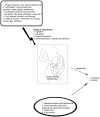Phthalate Exposure and Long-Term Epigenomic Consequences: A Review
- PMID: 32435260
- PMCID: PMC7218126
- DOI: 10.3389/fgene.2020.00405
Phthalate Exposure and Long-Term Epigenomic Consequences: A Review
Abstract
Phthalates are esters of phthalic acid which are used in cosmetics and other daily personal care products. They are also used in polyvinyl chloride (PVC) plastics to increase durability and plasticity. Phthalates are not present in plastics by covalent bonds and thus can easily leach into the environment and enter the human body by dermal absorption, ingestion, or inhalation. Several in vitro and in vivo studies suggest that phthalates can act as endocrine disruptors and cause moderate reproductive and developmental toxicities. Furthermore, phthalates can pass through the placental barrier and affect the developing fetus. Thus, phthalates have ubiquitous presence in food and environment with potential adverse health effects in humans. This review focusses on studies conducted in the field of toxicogenomics of phthalates and discusses possible transgenerational and multigenerational effects caused by phthalate exposure during any point of the life-cycle.
Keywords: DNA methylation; DOHAD; epigenomics; gestational exposure; phthalates.
Copyright © 2020 Dutta, Haggerty, Rappolee and Ruden.
Figures



Similar articles
-
Risk assessment of phthalates based on aggregated exposure from foods and personal care products and comparison with biomonitoring data.EFSA J. 2020 Nov 26;18(Suppl 1):e181105. doi: 10.2903/j.efsa.2020.e181105. eCollection 2020 Nov. EFSA J. 2020. PMID: 33294044 Free PMC article.
-
Exposure estimates of phthalates and DINCH from foods and personal care products in comparison with biomonitoring data in 24-hour urine from the Norwegian EuroMix biomonitoring study.Environ Int. 2021 Oct;155:106598. doi: 10.1016/j.envint.2021.106598. Epub 2021 May 3. Environ Int. 2021. PMID: 33957536
-
Polyvinyl Chloride Microplastics Leach Phthalates into the Aquatic Environment over Decades.Environ Sci Technol. 2022 Oct 18;56(20):14507-14516. doi: 10.1021/acs.est.2c05108. Epub 2022 Sep 26. Environ Sci Technol. 2022. PMID: 36154015 Free PMC article.
-
The effects of phthalates in the cardiovascular and reproductive systems: A review.Environ Int. 2016 Sep;94:758-776. doi: 10.1016/j.envint.2016.07.004. Environ Int. 2016. PMID: 27424259 Review.
-
Chemical behavior of phthalates under abiotic conditions in landfills.Rev Environ Contam Toxicol. 2013;224:39-52. doi: 10.1007/978-1-4614-5882-1_2. Rev Environ Contam Toxicol. 2013. PMID: 23232918 Review.
Cited by
-
Microbial Consortia and Mixed Plastic Waste: Pangenomic Analysis Reveals Potential for Degradation of Multiple Plastic Types via Previously Identified PET Degrading Bacteria.Int J Mol Sci. 2022 May 17;23(10):5612. doi: 10.3390/ijms23105612. Int J Mol Sci. 2022. PMID: 35628419 Free PMC article.
-
Phthalates and Non-Phthalate Plasticizers and Thyroid Dysfunction: Current Evidence and Novel Strategies to Reduce Their Spread in Food Industry and Environment.Toxics. 2025 Mar 19;13(3):222. doi: 10.3390/toxics13030222. Toxics. 2025. PMID: 40137549 Free PMC article. Review.
-
Integrated multi-omics analysis identifies TLR4-mediated mechanisms in ATBC-induced ovarian dysfunction and female infertility: A network toxicology, transcriptomic, and Mendelian randomization study.J Ovarian Res. 2025 Jun 3;18(1):120. doi: 10.1186/s13048-025-01708-0. J Ovarian Res. 2025. PMID: 40462131 Free PMC article.
-
Associations between prenatal phthalate exposure and childhood epigenetic age acceleration.Environ Res. 2023 Aug 15;231(Pt 1):116067. doi: 10.1016/j.envres.2023.116067. Epub 2023 May 5. Environ Res. 2023. PMID: 37149020 Free PMC article.
-
Unravelling the link between phthalate exposure and endometriosis in humans: a systematic review and meta-analysis of the literature.J Assist Reprod Genet. 2021 Oct;38(10):2543-2557. doi: 10.1007/s10815-021-02265-3. Epub 2021 Jul 6. J Assist Reprod Genet. 2021. PMID: 34227050 Free PMC article.
References
Publication types
Grants and funding
LinkOut - more resources
Full Text Sources

